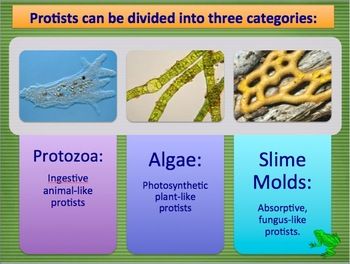plant like protists
Most have chloroplasts which are characteristic of algae and plants. They are simple eukaryotic microorganisms that do not fall into the plant animal bacteria or fungus groups.
 |
| The Great Diversity Of Protists Top Left The Animal Like Paramecium Aurelia Is A Ciliate Top Right The Plant Like Eug Protists Biology Biology Plants |
Turgor pressure is the force within the cell that pushes the plasma membrane against the cell wall.

. However they do include groups such as heterokontophyte alveolate dinoflagellate apicomplexa ciliophoran haptophyte and cryptophyta. Waste particles are expelled by an exocytic vesicle that fuses at a specific region on the cell membrane called the. Protists may have animal-like cell membranes plant-like cell walls or may be covered by a pellicle. For example protozoans are grouped as animal-like protists and algae are referred to as mixed groups of plant-like protists.
Obtain energy from decomposing organic material hetertrophs. Protists exhibit many forms of nutrition and may be aerobic or anaerobic. They have both plant and animal characteristics. However fungi can also have symbiotic mutually beneficial relationships with photosynthetic algae or bacteria and with plant roots.
A symbiotic association of a fungus and an animal that photosynthesizes is called a lichen while a plant root-and-fungus association is. Most protists are motile and generate movement with cilia flagella or pseudopodia. Processes such as insemination or pollination which happen before the fusion of gametes are also sometimes informally called fertilisation. Plant cells are differentiated from the cells of other organisms by their cell walls chloroplasts and central vacuole.
However some protists may behave like animals or plants. A protist is not an animal plant or fungus. They are usually not considered a kingdom and are not given any formal taxonomical classification. Reproduce using sporagia a structure found in fungi.
These kinds of protists also have the plant-like ability to perform photosynthesis. Amoebas and some other heterotrophic protist. Photosynthetic protists are considered plant-like protists. Interestingly some species confuse the scientists by exhibiting both characteristics of animal and plant.
Slime molds found in damp soil and on rotting food. Some protists are heterotrophs and ingest food by phagocytosis while other types of protists are photoautotrophs and store energy via photosynthesis. Fertilisation or fertilization see spelling differences also known as generative fertilisation syngamy and impregnation is the fusion of gametes to give rise to a new individual organism or offspring and initiate its development. Euglena is a large genus of unicellular protists.
Food captured in the oral groove enters a food vacuole where it combines with digestive enzymes. Protists that are capable of photosynthesis include various types of algae diatoms dinoflagellates and euglena. Chloroplasts are organelles that are crucial for plant cell function. Overview of Plant Cells.
Saprobic protists have the essential function of returning inorganic nutrients. These organisms are often unicellular but can form colonies. Those that store energy by photosynthesis belong to a group of photoautotrophs and are characterized by the presence of chloroplasts. 3Fungi-like - Absorb nutrients from the environment.
The genus Paramecium includes protists that have organized their cilia into a plate-like primitive mouth called an oral groove which is used to capture and digest bacteria. Slime molds page 517 water molds and labylathulomyetes. Features of both fungi and protists. In contrast bacteria and archaea are made up of a single prokaryotic cell.
Euglenids are believed to descend from an ancestor that took up green algae by secondary endosymbiosis. All live in water and move by means of a flagellumThis is an animal characteristic. Protists are one of the six kingdoms of life. Many fungus-like protists are saprobes organisms that feed on dead organisms or the waste matter produced by organisms saprophyte is an equivalent term and are specialized to absorb nutrients from nonliving organic matter.
Other fungi parasitize plants and are responsible for plant diseases like Dutch elm disease. It is also called hydrostatic pressure and is defined as the pressure in a fluid measured at a certain point within itself when at equilibrium. Generally turgor pressure is caused by the osmotic flow of water and occurs in plants fungi and bacteria. Other protists are heterotrophic and consume organic materials such as other organisms to obtain nutrition.
They also contain chlorophyll a pigment which absorbs light energy for photosynthesis. For instance many types of oomycetes grow on dead animals or algae. Most groups are autotrophic although some no longer have the. Animals fungi and protists are made of at least one eukaryotic cell.
 |
| Algae Ii Algae Aquatic Plants Protists |
 |
| Protists Facts And Types Animal Like Plant Like Fungus Like Protists Montessori Science Homeschool Science |
 |
| Kingdom Protista Protists Microscopic Organisms Biology Notes |
 |
| Protista Kingdom Algae And Protozoa Powerpoint And Notes Protists Science Biology Teaching Biology |
 |
| Pin By Cara Perry On Kingdom Protoctista Protists Fungi Teaching Biology |
Posting Komentar untuk "plant like protists"